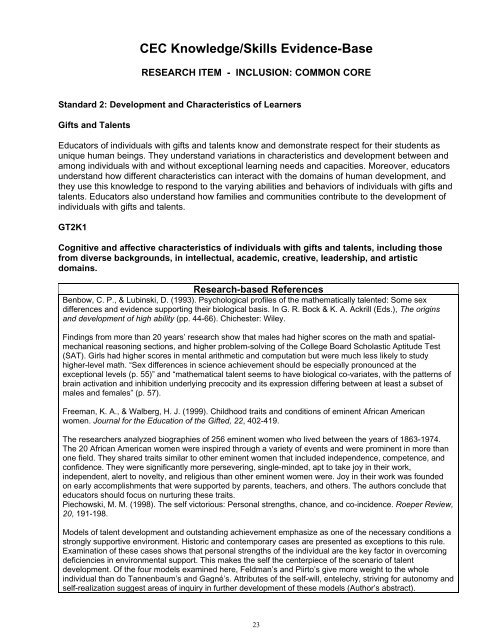Research Base - NAGC
Research Base - NAGC
Research Base - NAGC
Create successful ePaper yourself
Turn your PDF publications into a flip-book with our unique Google optimized e-Paper software.
CEC Knowledge/Skills Evidence-<strong>Base</strong>RESEARCH ITEM - INCLUSION: COMMON COREStandard 2: Development and Characteristics of LearnersGifts and TalentsEducators of individuals with gifts and talents know and demonstrate respect for their students asunique human beings. They understand variations in characteristics and development between andamong individuals with and without exceptional learning needs and capacities. Moreover, educatorsunderstand how different characteristics can interact with the domains of human development, andthey use this knowledge to respond to the varying abilities and behaviors of individuals with gifts andtalents. Educators also understand how families and communities contribute to the development ofindividuals with gifts and talents.GT2K1Cognitive and affective characteristics of individuals with gifts and talents, including thosefrom diverse backgrounds, in intellectual, academic, creative, leadership, and artisticdomains.<strong>Research</strong>-based ReferencesBenbow, C. P., & Lubinski, D. (1993). Psychological profiles of the mathematically talented: Some sexdifferences and evidence supporting their biological basis. In G. R. Bock & K. A. Ackrill (Eds.), The originsand development of high ability (pp. 44-66). Chichester: Wiley.Findings from more than 20 years’ research show that males had higher scores on the math and spatialmechanicalreasoning sections, and higher problem-solving of the College Board Scholastic Aptitude Test(SAT). Girls had higher scores in mental arithmetic and computation but were much less likely to studyhigher-level math. “Sex differences in science achievement should be especially pronounced at theexceptional levels (p. 55)” and “mathematical talent seems to have biological co-variates, with the patterns ofbrain activation and inhibition underlying precocity and its expression differing between at least a subset ofmales and females” (p. 57).Freeman, K. A., & Walberg, H. J. (1999). Childhood traits and conditions of eminent African Americanwomen. Journal for the Education of the Gifted, 22, 402-419.The researchers analyzed biographies of 256 eminent women who lived between the years of 1863-1974.The 20 African American women were inspired through a variety of events and were prominent in more thanone field. They shared traits similar to other eminent women that included independence, competence, andconfidence. They were significantly more persevering, single-minded, apt to take joy in their work,independent, alert to novelty, and religious than other eminent women were. Joy in their work was foundedon early accomplishments that were supported by parents, teachers, and others. The authors conclude thateducators should focus on nurturing these traits.Piechowski, M. M. (1998). The self victorious: Personal strengths, chance, and co-incidence. Roeper Review,20, 191-198.Models of talent development and outstanding achievement emphasize as one of the necessary conditions astrongly supportive environment. Historic and contemporary cases are presented as exceptions to this rule.Examination of these cases shows that personal strengths of the individual are the key factor in overcomingdeficiencies in environmental support. This makes the self the centerpiece of the scenario of talentdevelopment. Of the four models examined here, Feldman’s and Piirto’s give more weight to the wholeindividual than do Tannenbaum’s and Gagné’s. Attributes of the self-will, entelechy, striving for autonomy andself-realization suggest areas of inquiry in further development of these models (Author’s abstract).23
















